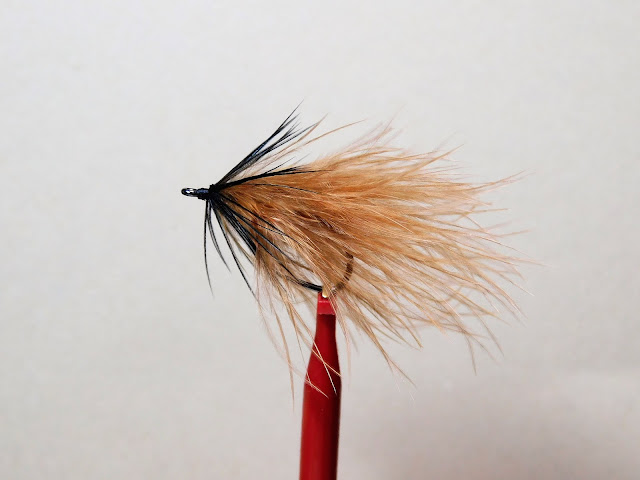Above is a Whiting Brahma Hen Cape, with Chickabou. These can be purchased for about 20.00. A Partridge cape retails for near 50.00.
Here is a feather taken from that hen cape. Notice how well marked it is. It is very similar to Partridge and can substitute easily. I also like the color which is dyed golden brown.
These soft hackles were tied with the feathers from the cape above.
This is a chickabou feather that also came from the cape above. It is that section that looks like a tail at the back of the cape. It has marabou likeness and it can be used various ways including "small" streamers.
Here is a "small" streamer tied with the use of chickabou feathers. Three feathers were used along with a black hen feather as a collar. The black gives the fly a contrast. Krystal Flash can also be added. The hook is a Firehole 718 #12...this fly will move in the water like a live baitfish.
Jack Gartside created the soft hackle streamer which this fly is based on. Jack used turkey marabou and tied larger streamers. Anyone who has ever fished on of Jack Gartside's patterns knows they get results.
These "small" streamers work well using the "Tiny Ten" tenkara rod.





I was under the impression that Brahma hen capes had larger feathers but maybe not. I'll have to take a look.
ReplyDeletebillp
DeleteThanks
Bill the feathers in smaller sizes can be found as you pick through the cape. I actually bought the cape for tying Irish mayflies and trout spey flies. Buying capes give you a variety.
Alan,
ReplyDeleteIt can become an obsession to obtain all the correct materials to match a recipe 100%. Unless you are a professional tyer one can go broke trying to do so for every pattern. I think it is more to satisfy the tyer then the fish.
Any fish that demands 100% accuracy is way too smart for me and I will unashamedly admit defeat and go on my way looking for dumber fish.
JJ
Beaverdam
DeleteThanks
Joe going broke is a real possibility. I am frugal and will search long and hard for a bargain, which there are many out there. It's true I don't think fish can tell the difference and some of the donkey's I tie have proven that.
Nice ties Alan. I especially like the bottom one.
ReplyDeleteMark Kautz
DeleteThanks
Mark that little streamer will get attention.
You've done it, you actually made purple on a hook look good. Those flies are gorgeous! I've always saved as much of the grouse chickabou as I can from the birds that we take; Gartside inspired small streamers work very well up here.
ReplyDeletemike
DeleteThanks
Mike may you be bending a bit on the color purple? If you have usable feathers why not save them. I have a bunch of odd partridge feathers that I might try to dye. Have never done that before.
Good little streamer pattern, with that chickabou feather, it reminds me of a "dancer" and even more if she moves a lot in the water ... even better ....
ReplyDeleteArmando Milosevic
DeleteThanks
Armando marabou moves very seductively in the water. Most fish will respond to it. A lot of great streamer patterns use marabou, now we have the chickabou streamers.
Alan
ReplyDeleteImpressed with the Hackles and the streamer----just wondering, which I think is somewhat away from the look of a traditional hackle; I'm talking about mulitcolors of thread when creating a hackle patten. Thanks for sharing
Bill Trussell
DeleteThanks
Bill thread bodies, especially silk thread possess a quality in the water that synthetic threads don't. Some when wet take on a different color. for instance some orange silk actually take on a rich brown color. They also show nicely through the movement of the soft hackles in the water. There simple construction is clear but there is complex action in the water.